Armament bombers-rocket carriers Xian H-6
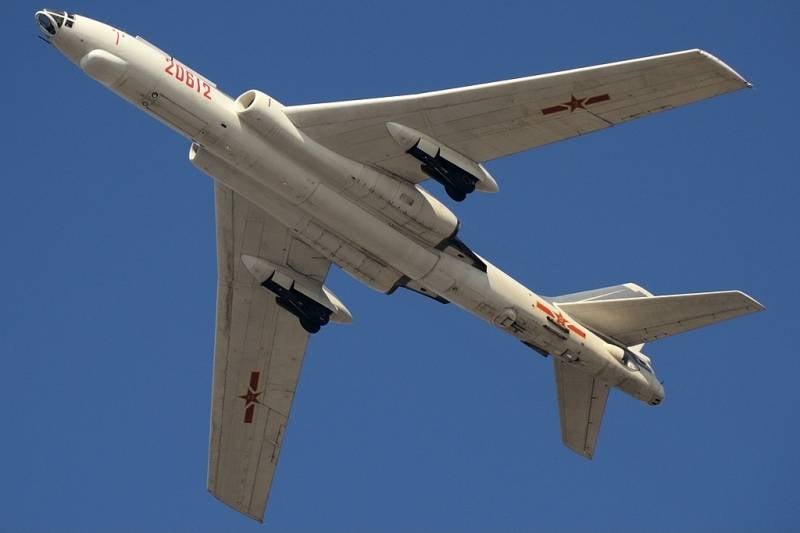
Bomber H-6A - one of the early modifications. Photo by Wikimedia Commons
Long-range bomber Xian H-6 entered service with the air force and naval aviation PLA in the early sixties and still remains in service. Such a long service life was obtained through regular upgrades and the creation of new modifications. In particular, as it developed, the bomber received one or another new weapon. Thanks to this, the modern H-6 fleet is able to use a wide range of missile weapons for various purposes.
In the process of development
The Chinese bomber H-6 of the first version was a licensed version of the Soviet Tu-16. He made his first flight in 1959, and in the early sixties entered service with the Air Force and Navy. In the first modification, it was a bomb carrier armed with conventional ammunition. Subsequently, a carrier of nuclear bombs, a tanker aircraft, etc. were created on its basis.
In the 6s, Chinese aircraft manufacturers began to develop new modifications of the H-XNUMX with missile weapons for striking ground and surface targets. This direction is still developing and has long been the main one. Various versions of the missile carriers were consistently developed, differing in the composition of the equipment, the list of compatible weapons, performance characteristics and combat capabilities.
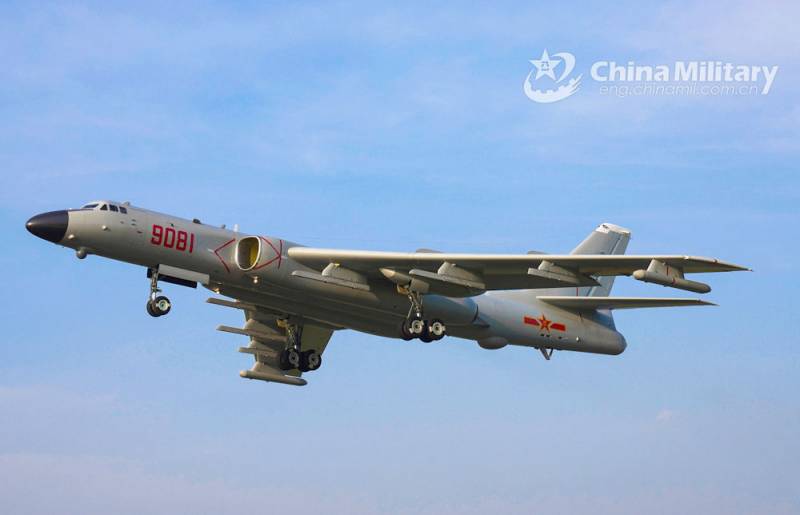
Modern H-6K with six underwing pylons. Photo Chinamil.com.cn
Due to the obvious advantages, newer modifications of the H-6 with missile weapons gradually replaced conventional bombers. Currently, the Air Force and Navy of the PLA have only missile carriers of this family, built according to several modifications. Their use is provided by tanker aircraft, reconnaissance aircraft, jammers, etc. on the same air platform.
According to The Military Balance 2022, the PLA Air Force now has seven bomber regiments on H-6 aircraft of various modifications, and a new brigade is being formed and equipped. There are also training units with older bombers. Naval aviation has only two H-6 regiments.
The total number of H-6 aircraft may exceed 215-220 units. The most numerous are the H-6K modification aircraft - the Air Force serves approx. 100 units The Navy has 18-20 similar H-6Js adapted to fly over the sea. The Air Force remains approx. 60 older H-6Hs gradually upgraded to H-6M status. The Navy has up to 25-30 non-new H-6Gs, which will be replaced by "J" version aircraft in the future. For the Air Force, the newest H-6N is being built in a small series. In addition, 10-12 old H-6A bombers are used for training purposes.
For ground targets
H-6 bombers from the PLA Air Force and Navy are capable of hitting enemy ground targets. Their targets are fixed structures, troop concentrations, etc. Target coordinates can be known in advance or set in flight, incl. after dropping the weapon. To solve such problems, it is proposed to use mainly guided missiles of various types.
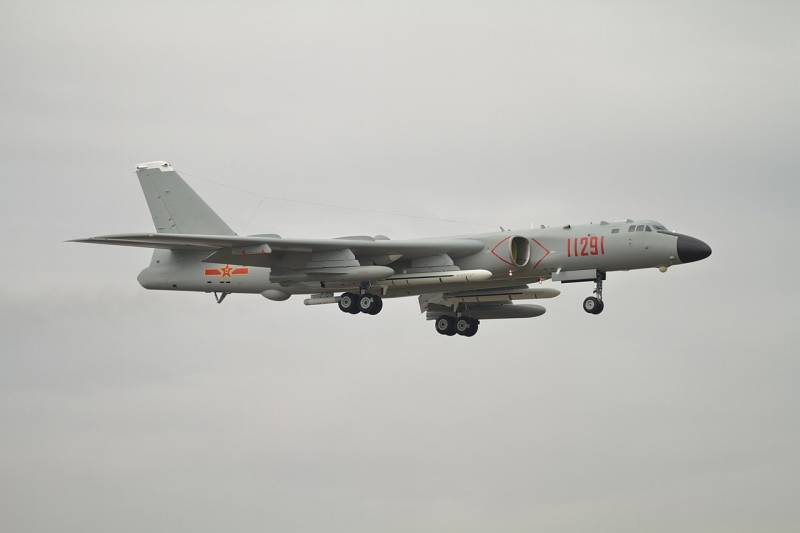
H-6K with a pair of CJ-10 or CJ-20 missiles (center) and two Hongniao products
According to known data, one of the main air-to-ground weapons for the H-6 are subsonic air-launched cruise missiles of the Hongniao series, which have been in service since the late nineties. It is known about the existence of three missiles of the family with different characteristics. All Hongniao missiles are equipped with a turbojet engine and are guided by satellite and inertial navigation. There are conventional and nuclear modifications. The very first rocket of the series, HN-1, had a range of up to 600 km, and for the HN-3 this parameter exceeded 1200-1500 km.
In the 10s, the deployment of more advanced subsonic CJ-6K ALCMs began. Such a weapon could be used by the latest modification of the H-1500K bomber and was supposed to deliver a conventional or nuclear warhead at a distance of up to 20 km. Later, the Changjian-2 missile appeared with a range of at least XNUMX km.
A few years ago, it became known that China was developing an aeroballistic modification of the Dongfeng-21 rocket. The range of such a product will reach 3 thousand km. They are planned to arm the aircraft of the latest modification H-6N.
To hit targets within a radius of tens of kilometers, H-6 aircraft can use guided bombs. The compatibility of such a bomber with the modern LT PGB family of bombs is reported. It includes several products with a caliber up to 1000 kg with semi-active laser guidance or satellite / inertial navigation.
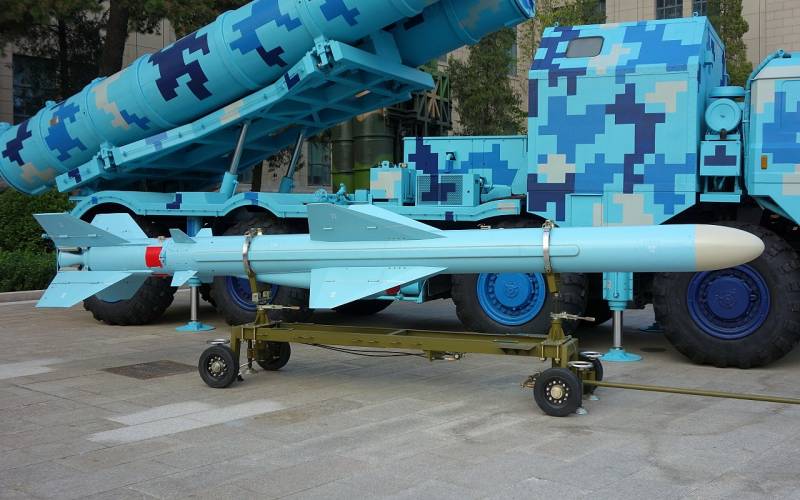
A KD-88 anti-ship missile in front of a compatible coastal launcher. Photo by Wikimedia Commons
Depending on the modification, the H-6 missile bombers are capable of carrying several missiles or bombs. So, on the earlier H-6H, there were only two underwing points for large missiles or beam holders for bombs, and in modifications "K" and "M" their number was increased to 4-6. In the H-6N project, the design of the fuselage bottom and cargo compartment was redesigned, as a result of which the aircraft can carry a large DF-21 missile in a semi-submerged position.
Anti-ship weapons
A number of anti-ship missiles are intended to destroy mobile surface targets. All missile-carrying modifications of the H-6 can carry them. Accordingly, both the Air Force and the Navy can fight enemy ships. At the same time, due to the presence of various aircraft modifications in service, the capabilities of the two types of troops differ slightly.
One of the oldest anti-ship missiles in service is Yingji-63. This is a deeply modernized version of the older Shangyu product - the Chinese version of the Soviet P-15 anti-ship missiles. During the processing, the design was changed and new devices were introduced. Flight range increased to 200 km.
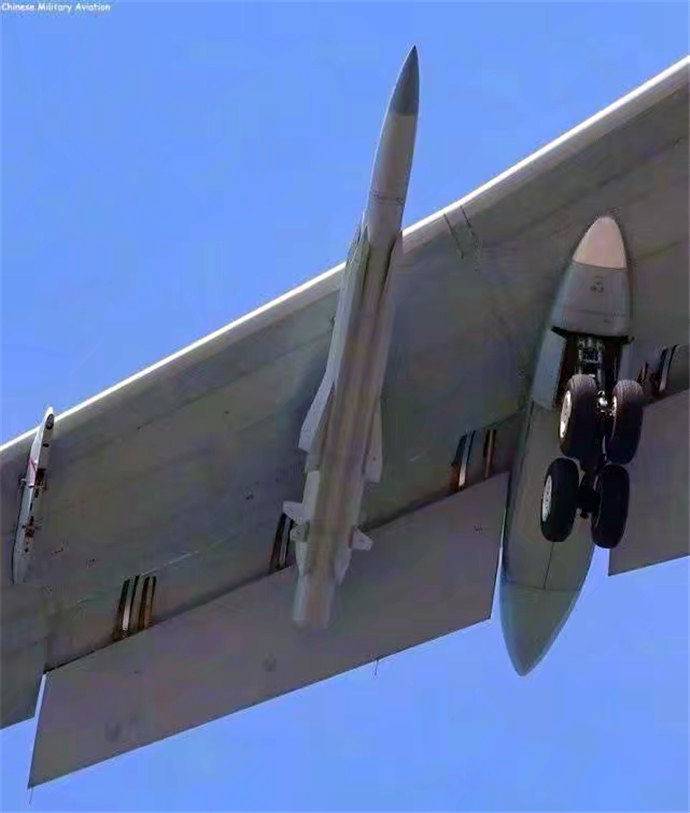
RCC YJ-12 on the underwing assembly. Photo by Globalsecurity.org
In the same period, the Kundi-88 anti-ship missile was developed and put into service. This is a supersonic missile with a ramjet engine and radar guidance. The flight range reached 200 km. The target was hit by a semi-armor-piercing warhead with a mass of 165 kg and a speed of about 3,5 Mach.
At the beginning of the tenth, it became known about the testing and / or development of anti-ship missiles of the Yingji-12 type. In technical terms, it is similar to the previous KD-88, but differs in increased size and weight, and also carries a heavier 500-kg warhead. When launched from an air platform, a flight range of up to 350-400 km is provided. The speed increased to 3,5-4 M.
During the development of the CJ-10 cruise missile, the YJ-100 product was created. This anti-ship missile has subsonic speed and flies 800 km. A 500-kg warhead is delivered to the target. The type of targeting is unknown. Probably, a combination of navigation systems and some kind of GOS is used.
In the context of creating an aeroballistic version of the DF-21 missile, there were reports of the possibility of a similar processing of anti-ship missiles of the DF-21D coastal complex. If work in this direction is really underway, their result can be officially shown in the foreseeable future.
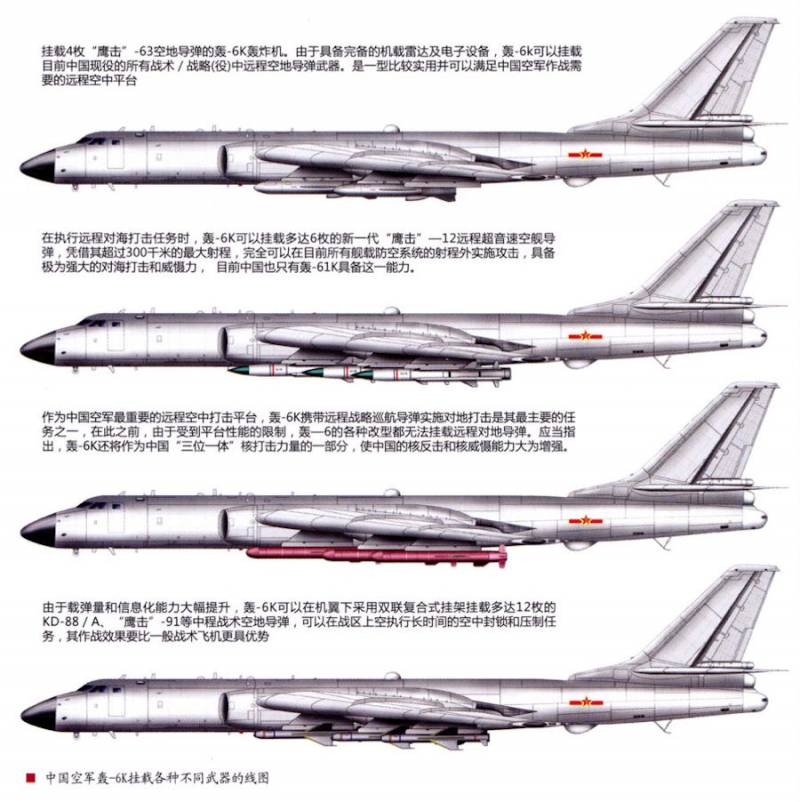
Different payload options for the H-6K. From top to bottom: 4 YJ-63 missiles; 6 YJ-12 missiles; 6 ALCMs of type CJ-10/20; 6 products KD-88. Globalsecurity.org graphics
Like "land" bombers, H-6 naval aviation carry missiles only on an external sling. In terms of payload and weapon placement, they do not differ from H-6H/M/K aircraft. Depending on the assigned ammunition load, a missile carrier can take on board at least 4-6 missiles. Smaller items such as the KD-88 can be hung in pairs on the same pylon.
Armament and modernization
The Xian H-6 missile bomber is very old, and its design has long been obsolete. Despite all the upgrades and alterations, the introduction of new engines and equipment, such an aircraft can no longer be considered a modern and convenient platform. In terms of performance characteristics, it is inferior to foreign technology of its class, and operation and use face certain restrictions.
However, the PLA and the Chinese aviation industry continue to develop the H-6 aircraft family and get the best possible results. One of the ways of such development is the regular and timely modernization of the weapons complex and related systems. Almost constantly new devices and weapons are being created and introduced.
Apparently, the command of the PLA Air Force and Navy considers this approach correct and expedient, and also does not plan to abandon it. This means that H-6 bombers of current modifications will retain a wide range of guided missile and bomb weapons, and in the foreseeable future they will receive new generation products. As a result, the combat qualities of the obsolete bomber, despite all the objective limitations, will remain at an acceptable level.
Information